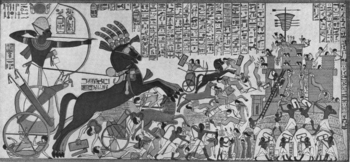Siege of Dapur
| Siege of Dapur | |||||||||
|---|---|---|---|---|---|---|---|---|---|
| Part of the Egyptian-Hittite wars | |||||||||
 The siege of Dapur on a mural in Ramesses II's temple in Thebes | |||||||||
| |||||||||
| Belligerents | |||||||||
| New Kingdom of Egypt | Hittite Empire | ||||||||
| Commanders and leaders | |||||||||
| Ramesses II | Unknown | ||||||||
| Strength | |||||||||
| Unknown | Probably fewer | ||||||||
| Casualties and losses | |||||||||
| Unknown (probably lower) | Unknown | ||||||||
The Siege of Dapur occurred as part of Ramesses II's campaign to suppress Galilee and conquer Syria in 1269 BC. He described his campaign on the wall of his mortuary temple, the Ramesseum in Thebes. The inscriptions say that Dapur was "in the land of Hatti".[1] Although Dapur has often been identified with Tabor in Canaan, Kenneth Kitchen argues that this identification is incorrect and that the Dapur in question is in Syria,[2] to the north of Kadesh.[3]
From Egyptian reliefs we can see that Dapur was a city, heavily fortified with both inner and outer walls, and situated on a rocky hill which was usual for Syrian cities and many other cities in the Bronze Age.
Contemporary illustrations of the siege show the use of ladders and chariots with soldiers climbing scale ladders supported by archers. Six of the sons of Ramesses, still wearing their side locks, also appear on those depictions of the siege. Those include:
| “ |
King's son, of his body, his beloved, Khamwese. King's son, of his body, his beloved, Montu[...]. King's son, of his body, his beloved, Meriamon. King's son, of his body, his beloved, Amenemuya. King's son, of his body, his beloved, Seti. King's son, of his body, his beloved, Setepnere. |
” |
References
- ↑ Kitchen, Kenneth A (1998-12-17). Ramesside Inscriptions. Wiley-Blackwell. p. 83. ISBN 978-0-631-18435-5.
- ↑ Kitchen, Kenneth A (1998-12-17). Ramesside Inscriptions. Wiley-Blackwell. p. 56. ISBN 978-0-631-18435-5.
- ↑ M. Healy, Qadesh 1300 BC: Clash of the warrior kings, 87
- James Henry Breasted, Ancient Records of Egypt, Part III § 359.